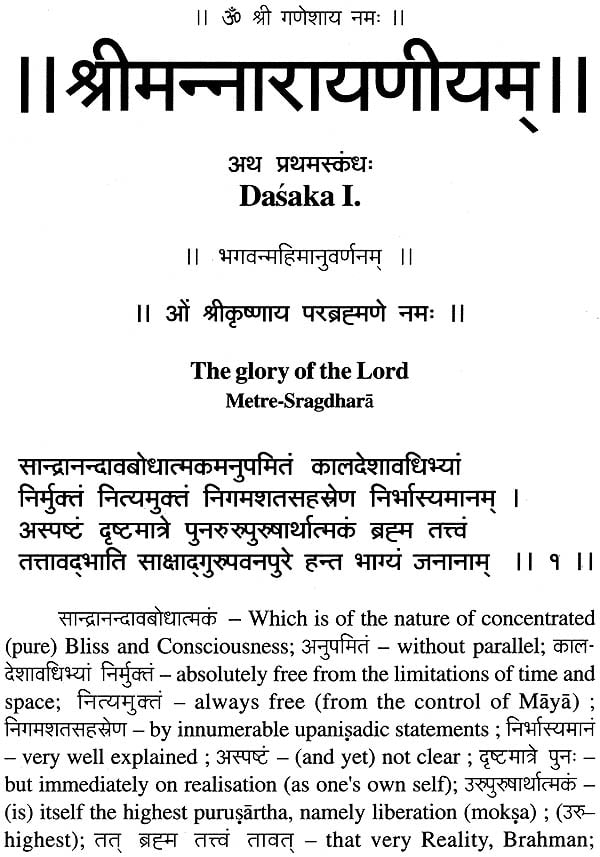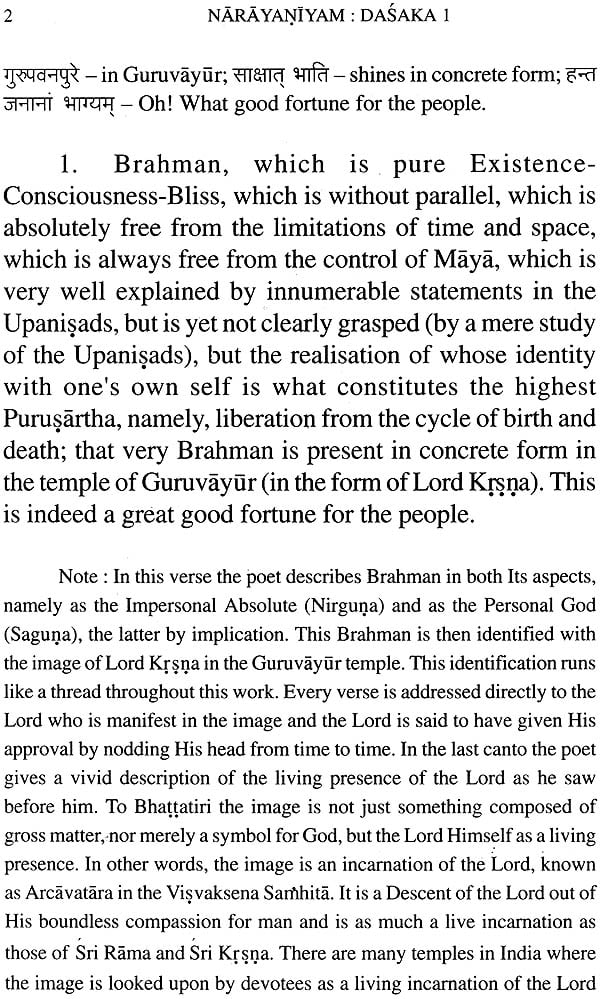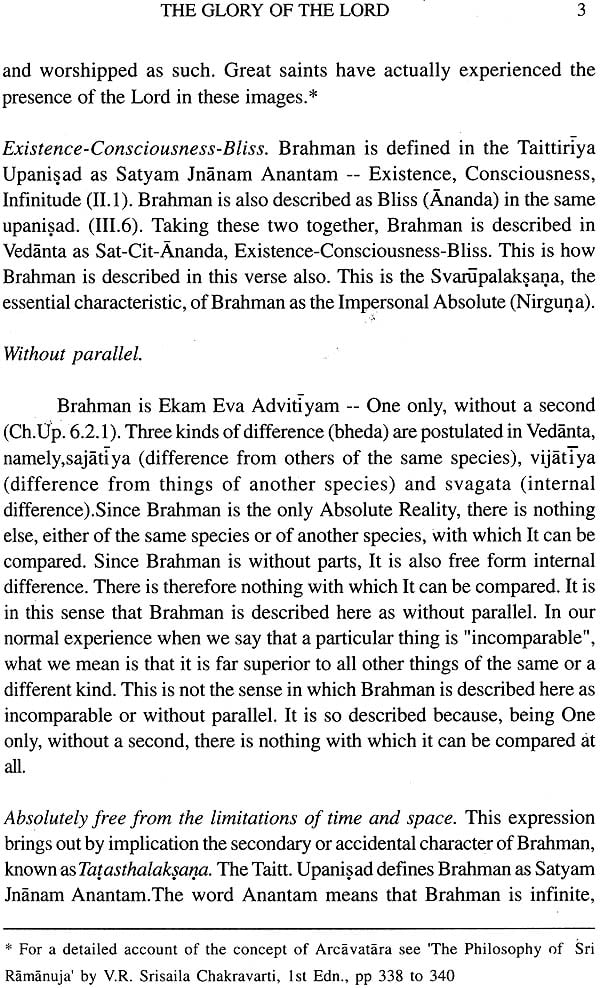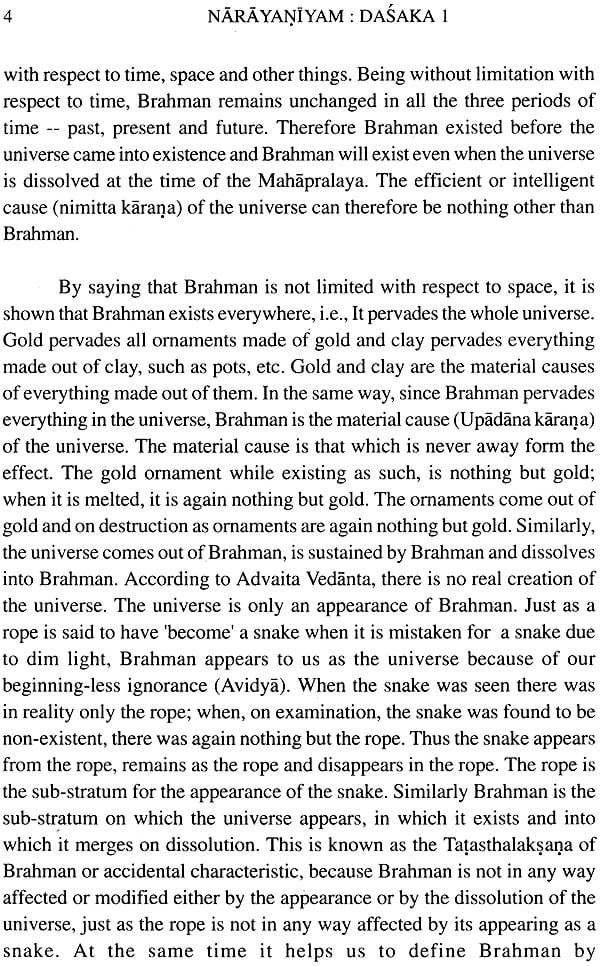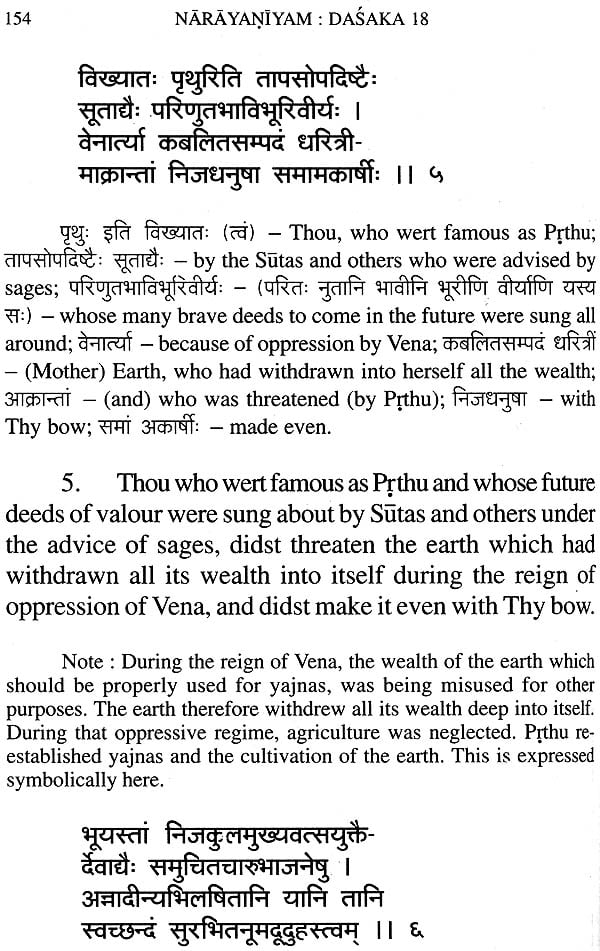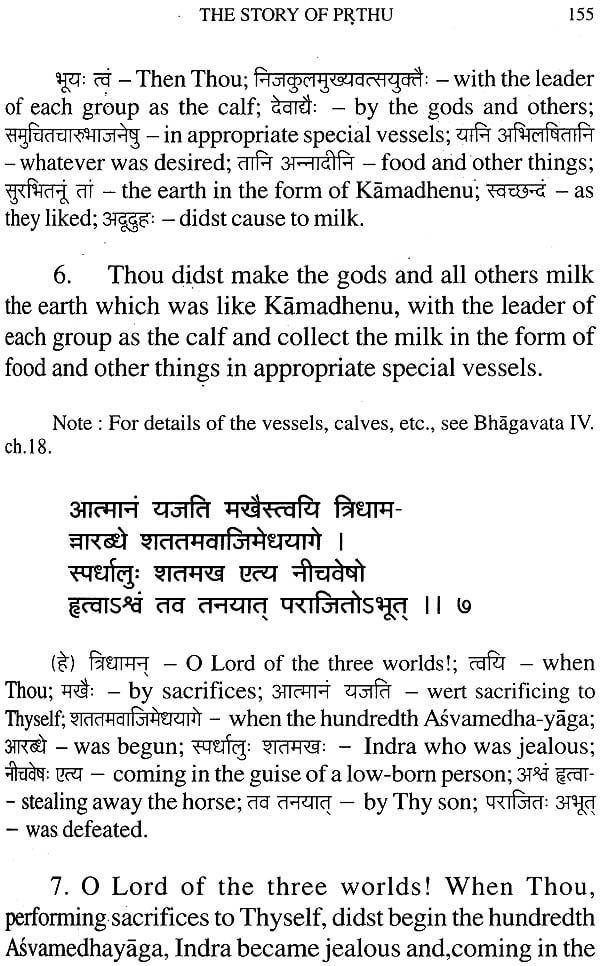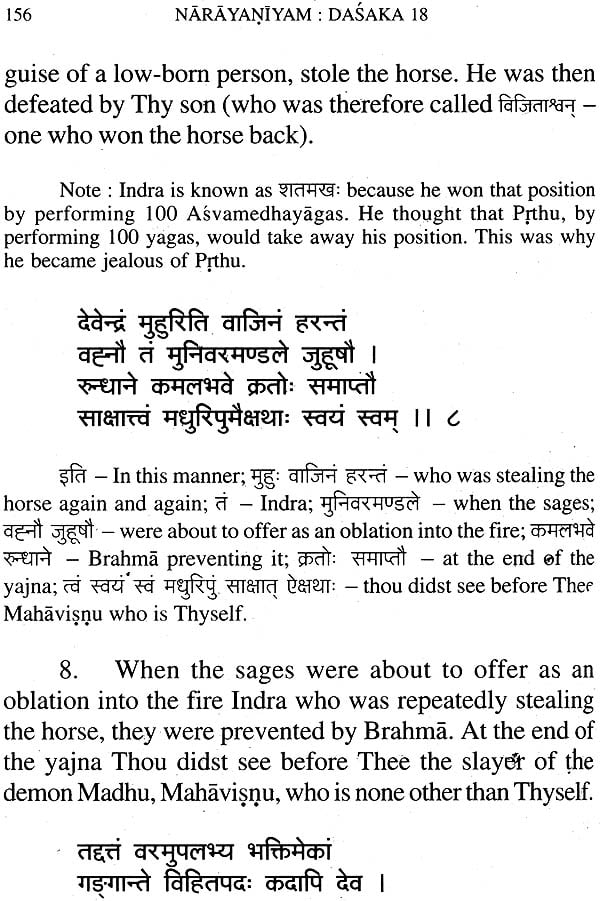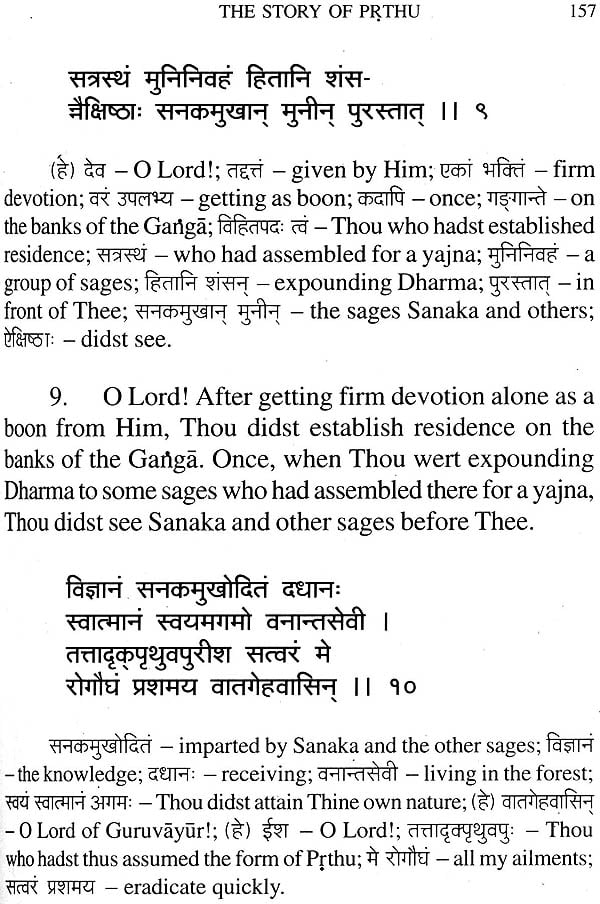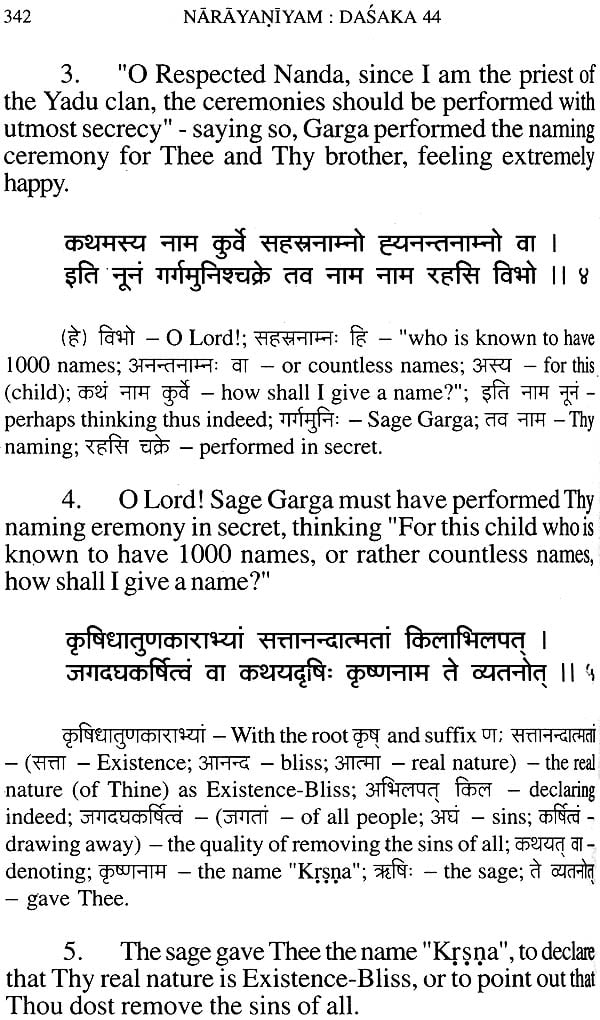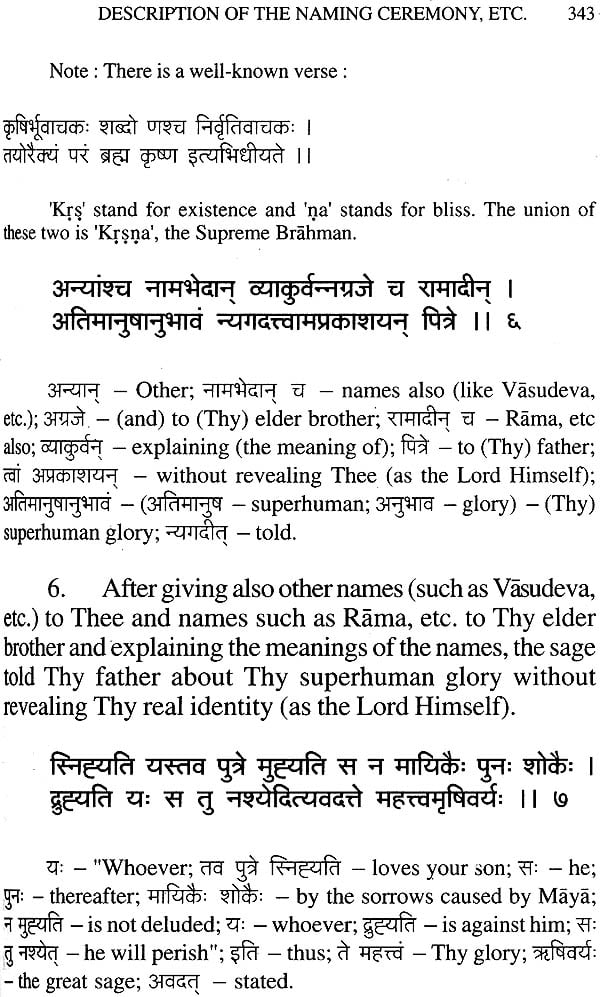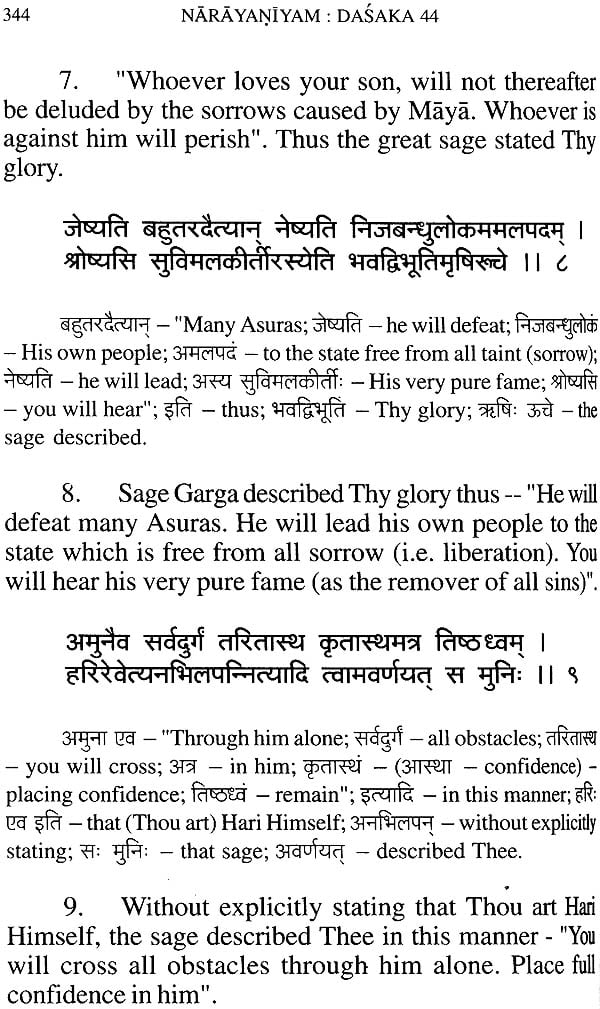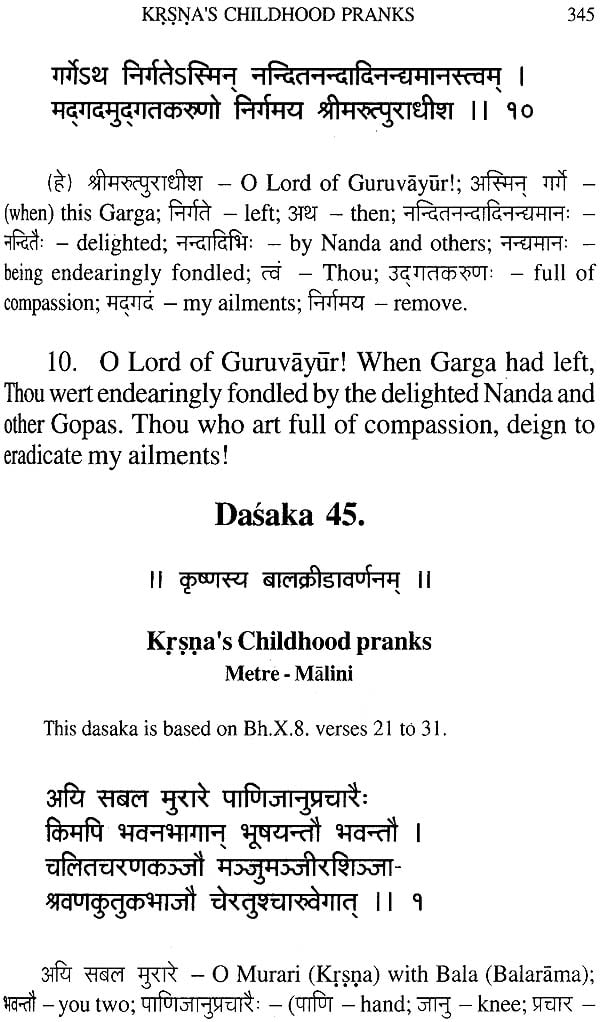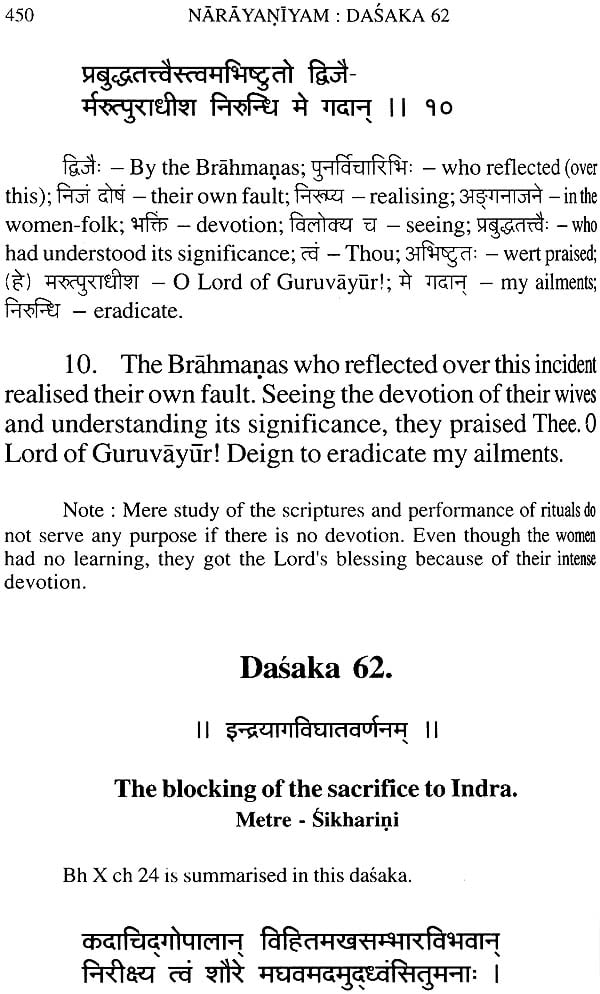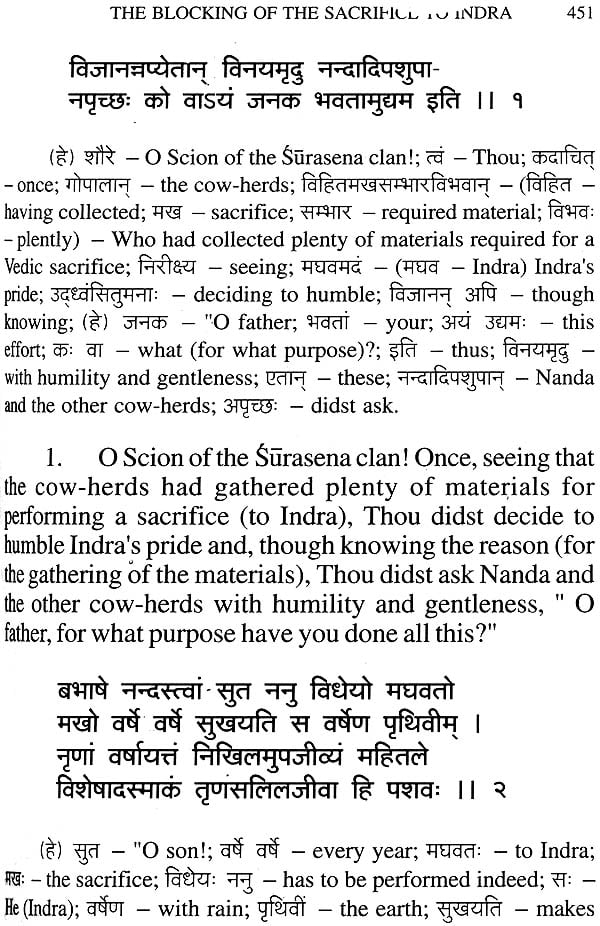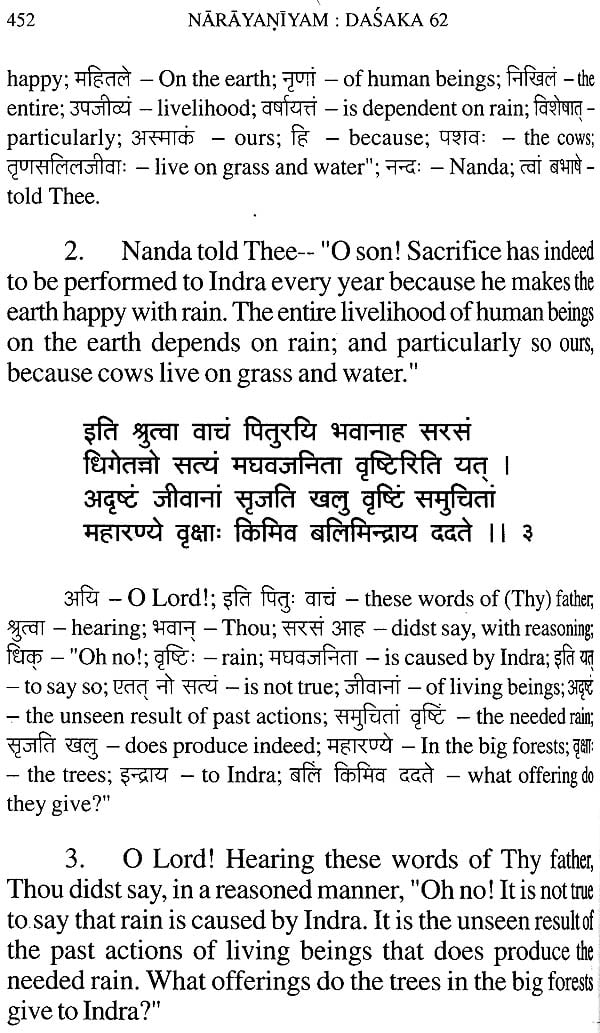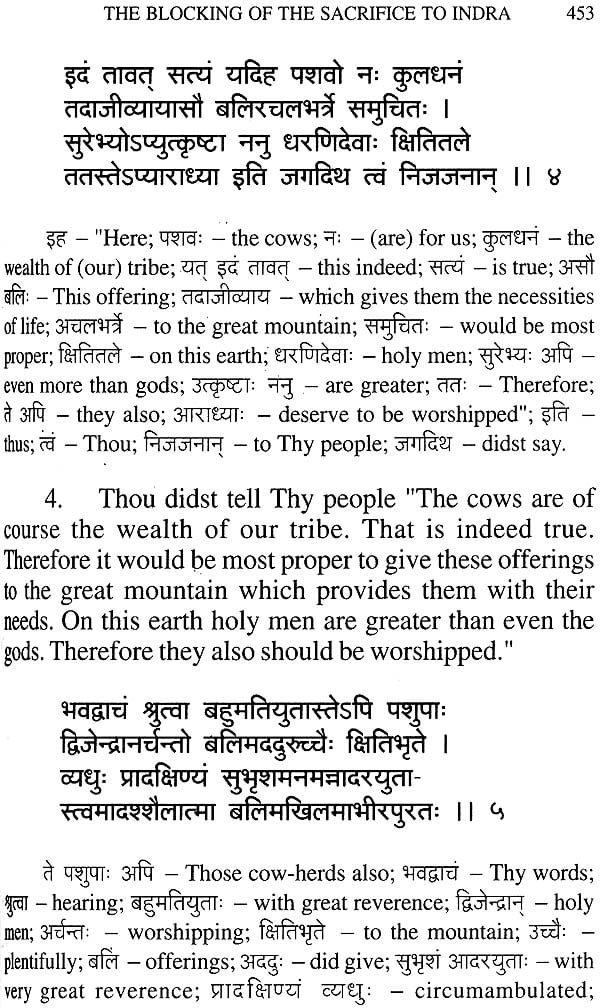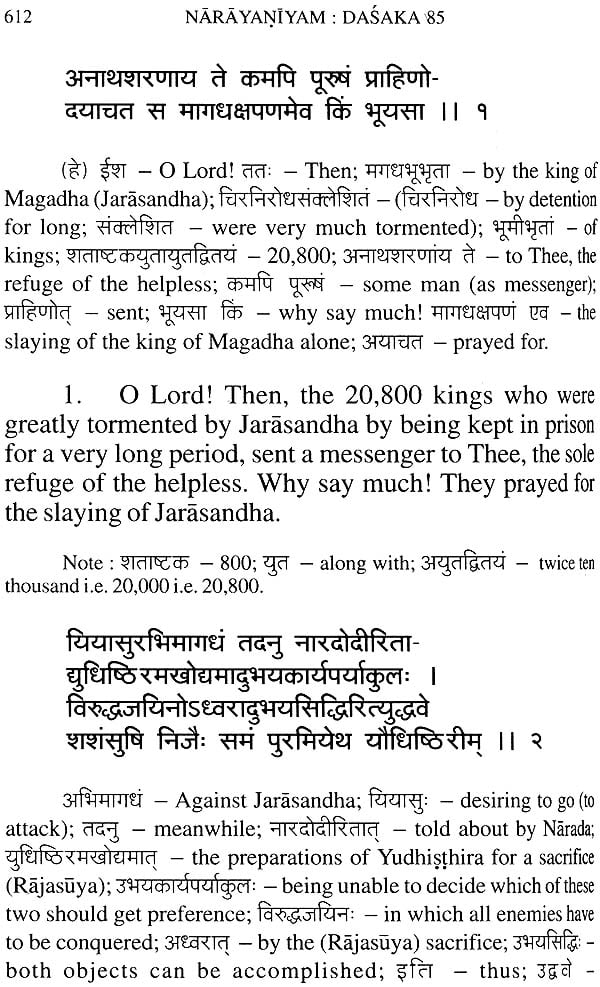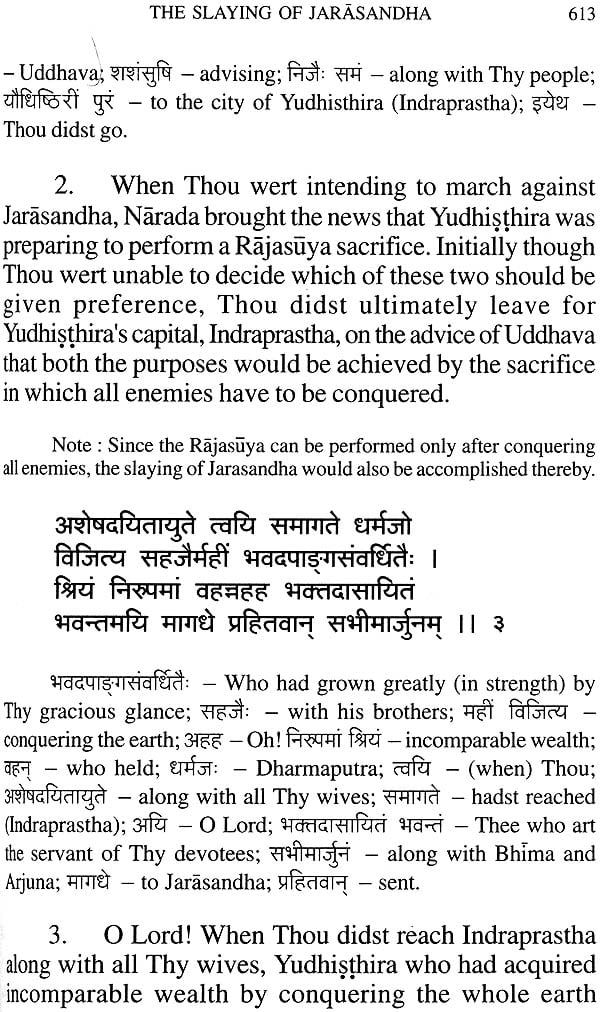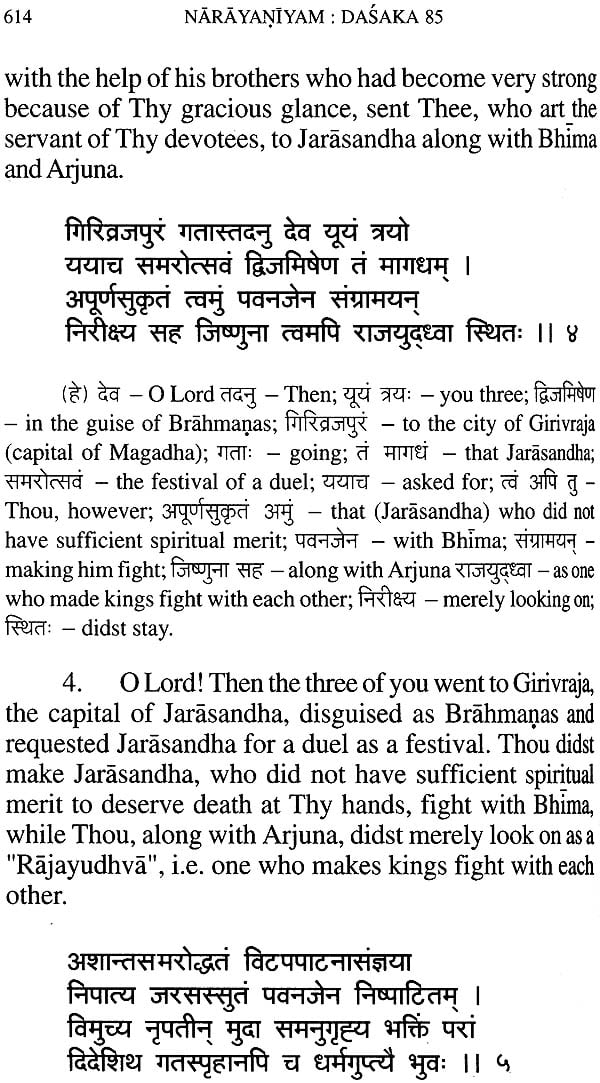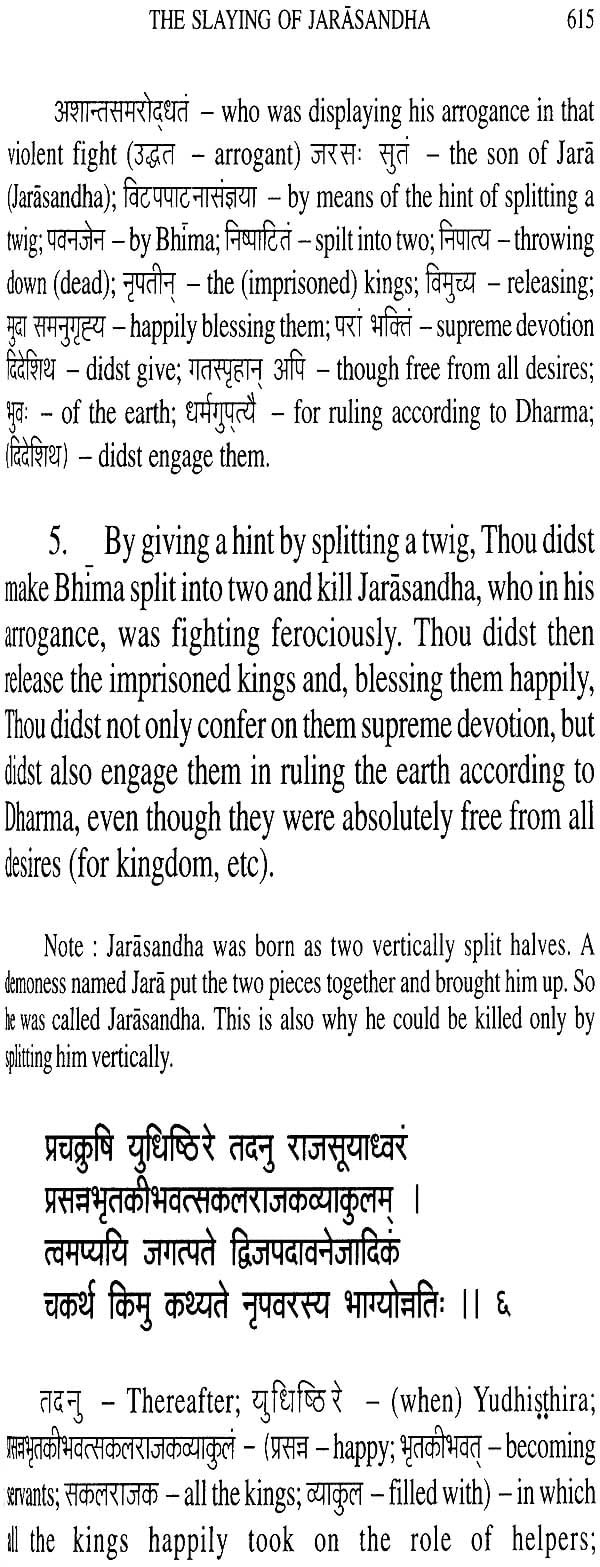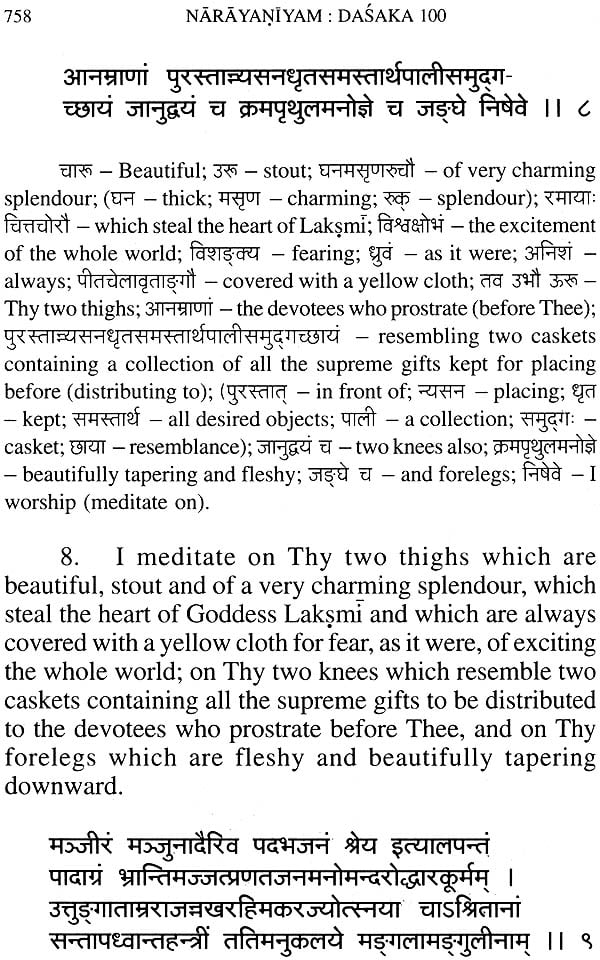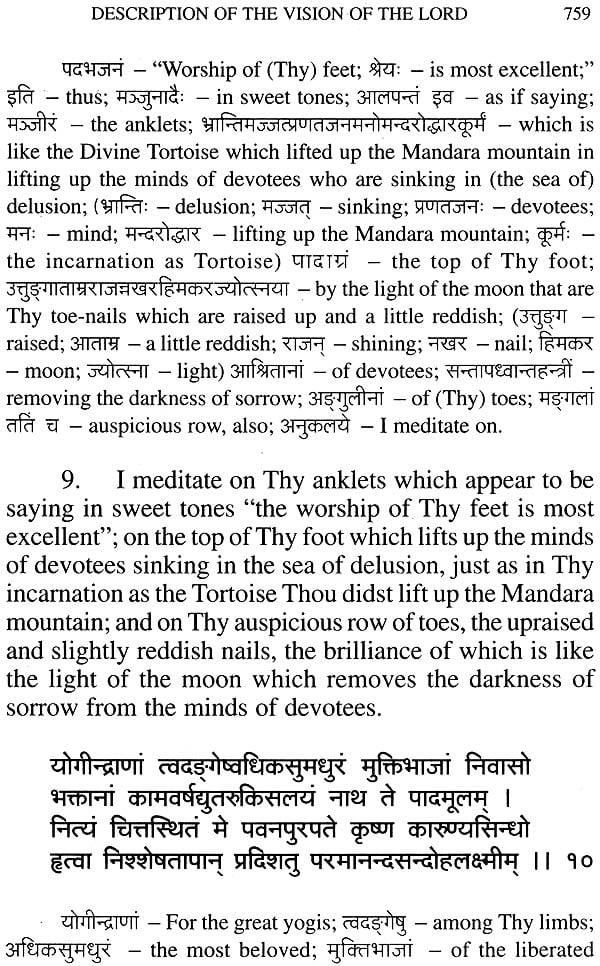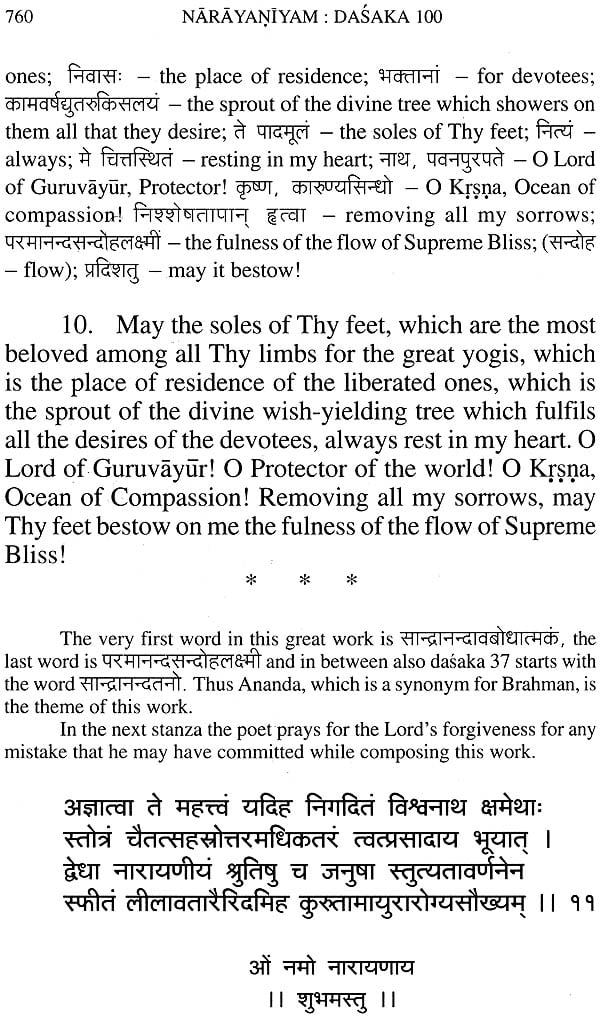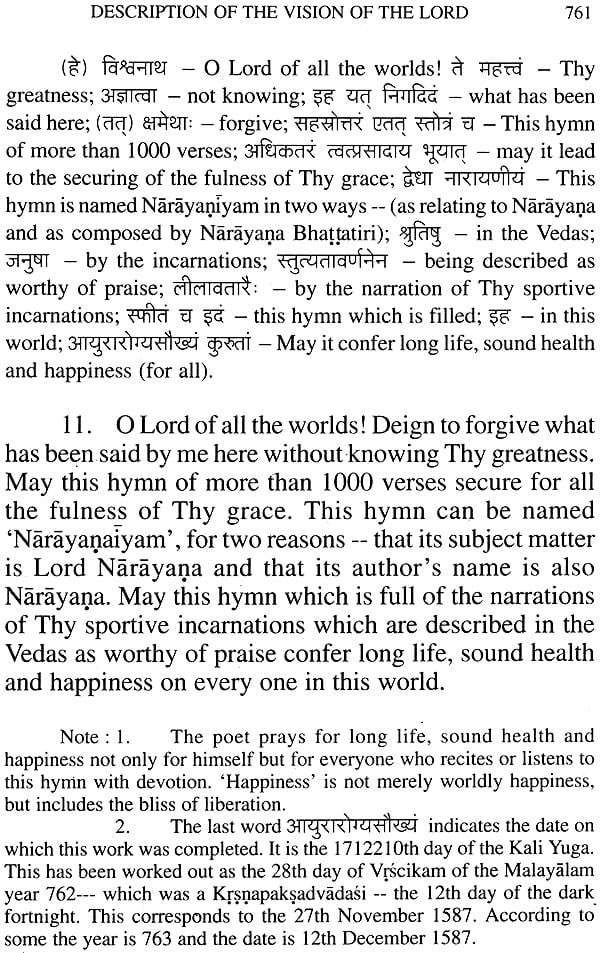
Narayaneeyam
Book Specification
| Item Code: | IDI937 |
| Author: | S. N. Sastri |
| Publisher: | CENTRAL CHINMAYA MISSION TRUST |
| Language: | (Sanskrit Text, Word to Word Meaning, English Translation and Notes) |
| Edition: | 2021 |
| ISBN: | 9788175972667 |
| Pages: | 761 |
| Cover: | Hardcover |
| Other Details | 9.0" X 6.0" |
| Weight | 1 kg |
Book Description
From the Jacket:
Srimannarayaniyam is a devotional work of a littleover one thousand verses by the famous devotee-poet Sri Melpathur Narayana Bhattatiri who lived in Kerala in the 16th century A.D. This work is acclaimed by scholars as a stotrakavya, a superb outpouring of devotion as well as a literary work of a very high order. It is a masterly condensation of Srimad Bhagavata, considered to be the greatest of all the Puranas. In addition to being a devotional work Srimannarayaniyam contains the gist of all the Upanishads and is therefore, a work of great significance from the Vedantic point of view also. This commentary in English by S.N. Sastri conveys to the reader the extraordinary poetic quality of the work and brings out the Vedantic import of the verses in an elaborate and lucid manner. Pujya Gurudev Swami Chinmayananda has said in this commentary-"I am sure the reader will enjoy many flights at super-human heights in the journey through Sastri's exposition of immortal NARAYANEEYAM".
I never thought veteran bureaucrats could understand Vedanta! That is, until I saw Shri S. N. Sastri's beautiful work on NARAYANEEYAM. He seems to have delved deep. And in preparing the manuscript with word-to-word meaning, translation and commentary particularly from the Vedantic angle, Sastri has done a thorough job. In fact, the entire credit for the book belongs to him.
Melpathur Narayana Bhattatiri was an unique personality: erudite Sanskrit scholar, poet, Bhakta, Vedantin. Imagine the audacity of a young man in his twenties attempting a summary of Vyasa's Bhagavatam in Sanskrit hymns! And see also the literary beauty, devotional content and Vedantic insight built into NARAYANEEYAM by Bhattatiri. Nothing short of poetic frenzy could have produced this artistry. No ecstasy of ritualistic devotion could have created such a touching hymn. NARAYANEEYAM is also a standing monument to Bhattatiri's deep insight in Vedanta.
If this volume is slightly heavy, the content deserves it. And I am sure the reader will enjoy many flights at super-human heights in the journey through Sastri's exposition of immortal NARAYANEEYAM.
May the Guru's Grace be with us all.
Nov. 6, 1988.
Srimannarayaniyam is a masterly condensation of the famous Bhagavata Mahapurana and was composed by Melpathur Narayana Bhattatiri, a great devotee-poet who lived a kerala during the 16th century A.D. The Bhagavata, consisting of about 18000 verses, has been summarised in this work in 1034 verses, divided into 100 dasakas (cantos). This work occupies a very high place in Sanskrit literature, both because of the intense devotional fervour of the verses and because of their extraordinary literary merit.
The author of this work, Melpathur Narayana Bhattatiri, was born about the year 1560 A.D. in a village near the famous temple of Tirunavaya in Kerala. Even at a very young age he mastered the Vedas and the vedangas. He learnt Mimamsa and other Sastras from his father Matrudatta, the Vedas from one Madhavacharya, the science of logic (Tarka) from his elder brother Damodara and Sanskrit grammar from one Achyuta Pisharoti, a celebrated grammarian. He composed the Narayaniyam at the age of 27. He wrote a monumental work on Sanskrit grammar, entitled Prakriyasarvasva, a work similar to the Siddhanta Kaumudi, but written earlier. It is said that Bhattoji Dikshita, the author of the Siddhanta Kaumudi, on hearing about Bhattatiri, set out for Kerala to meet him, but had to return disappointed on hearing on the way that Bhattatiri had passed away. Bhattatiri composed many other devotional hymns also, as well as a work on Purvamimamsa entitled Manameyodaya and panegyrics in praise of his royal patrons. It is believed that he lived till the ripe old age of 105, honoured by all for his great erudition, his superb literary creations and above all, for his supreme devotion.
The circumstances which led to the composition of Narayaniyam by Bhattatiri in his 27th year are as follows. His Guru in Sanskrit grammar, Achyuta Pisharoti, fell victim to a severe attack of paralysis and suffered unbearable pain. Bhattatiri, the devoted disciple that he was, could not bear the suffering of his Guru. He therefore fervently prayed that the disease may be transferred to him and his Guru freed of suffering. It happened as he wanted and soon, while Pisharoti recovered, the fell disease made Battatiri a cripple. It was the general belief in those days, as it is now, that sincere prayers to the Lord of Guruvayur would bring immediate relief from all troubles. Bhattatiri, who was unable even to move, had himself carried to the Guruvayur temple and sat there spending his time in prayer. He was then advised by Tunchath Ezhuthachan, an eminent Malayalam poet of the time, that he would be cured of his disease if he composed a hymn recounting all the incarnations of the Lord. Accordingly, he started composing the Narayan iyam, at the rate of one da saka (canto) consisting generally of 10 verses, every day. On the 100th day he had a vision of the Lord in the form of Venugopala. The 100th canto, composed on that day, gives a graphic description of this form from head to foot. On that day he became completely cured of his disease.
In the 100th canto the poet says that he has named this work Narayan iyam for two reasons – (1) it is about Lord Narayana and (2) the poet’s name is also Narayana.
From the word ‘Ayurarogyasaukhyam’ appearing at the end of the 100th canto scholars have worked out the date of completion of the work as the 28th day of the Malayalam month of Vrischikam of the Malayalam year 762 corresponding to 27th November 1587. (According to some the year is 763 and the sate is 12th Dec. 1587).
As a devotional hymn, this work ranks among the best of its kind. The superiority of the path of devotion, as compared with the paths of action (Karma) and knowledge (Jnana) is repeatedly stressed by the poet. He points out that Bhakti grows in the heart of an individual without any special effort on his part if he merely listens to the narrations about the incarnations and the deeds and excellences of the Lord. Bhakti is nothing but intense love for God. It is natural for every human being to love anything beautiful and so, to develop love for the Lord of Guruvayur who is beauty incarnate, does not need any effort. Unlike the path of Jnana which is possible only for those who have developed a high degree of detachment, the path of Bhakti is open to everyone. But devotion in the real sense of the term is possible only when it is informed by some knowledge of the relationship between the world and God, between the individual and God and between the individual and the world. These matters are dealt with in the first 10 and the last 10 cantos. These cantos thus contain the essence of all the Upanisads. Every verse is addressed to the Lord. This work is considered eminently suitable for daily Parayanam (devout reading) by devotees. In these days when life is full of tensions and problems, the reading of at least a few verses every day is the surest way to preserve one’s equanimity and enjoy inward peace.
| Page | ||
| Foreword by H.H Swami Chinmayananda | v | |
| Introduction | vii to xii | |
| Transliteration | xviii | |
| Dasaka | ||
| 1. | The glory of the Lord | 1 |
| 2. | The form of the Lord | 20 |
| 3. | The qualities of the perfect devotee | 29 |
| 4. | Yoga and its attainment | 38 |
| 5. | Cosmic Evolution | 49 |
| 6. | The Cosmos as the form of the Lord | 59 |
| 7. | Brahma's origin and penance | 66 |
| 8. | Description of Pralaya | 75 |
| 9. | Description of creation | 84 |
| 10. | The variety of creation | 92 |
| 11. | Entry of Sanaka and others into Vaikuntha | 99 |
| 12. | The Boar Incarnation | 106 |
| 13. | The slaying of Hiranyaksa | 113 |
| 14. | The Kapila Incarnation | 120 |
| 15. | The teaching of Kapila | 127 |
| 16. | Nara Narayana and Daksayaga | 135 |
| 17. | The story of Dhruva | 143 |
| 18. | The story of Prthu | 151 |
| 19. | The story of Pracetas | 158 |
| 20. | The story of Rsabhayogisvara | 165 |
| 21. | Mode of worship in Jambudvipa, etc | 171 |
| 22. | The story of Ajamila | 179 |
| 23. | The stories of Daksa, Citraketu, etc | 186 |
| 24. | The story of Prahlada | 194 |
| 25. | The Incarnation as Narasimha | 202 |
| 26. | The liberation of Gajendra | 211 |
| 27. | The churning of the Milk Ocean | 217 |
| 28. | The churning of the ocean(cont.) | 225 |
| 29. | The Mohini incarnation, etc. | 231 |
| 30. | The Vamana incarnation | 238 |
| 31. | The humbling of Bali | 244 |
| 32. | The Fish incarnation | 252 |
| 33. | The story of Ambarisa | 258 |
| 34. | The Incarnation as Sri Rama | 264 |
| 35. | The Incarnation as Sri Rama(contd.) | 273 |
| 36. | The Incarnation as Parasurama | 283 |
| 37. | The Prelude to the Incarnation as Krsna | 293 |
| 38. | The Birth of Sri Krsna | 301 |
| 39. | Bringing Yogamaya from Gokulam, etc. | 308 |
| 40. | The salvation of Putana | 317 |
| 41. | The cremation of Putana, etc. | 322 |
| 42. | The slaying of Sakatasura | 327 |
| 43. | The slaying of Trnavarta | 333 |
| 44. | Description of the naming ceremony, etc. | 340 |
| 45. | Krsna's childhood pranks | 345 |
| 46. | Revelation of the Cosmic Form | 352 |
| 47. | Tying Krsna to the mortar | 357 |
| 48. | The Redemption of Nalakubara and Manigriva | 363 |
| 49. | Journey to Vrndavana | 369 |
| 50. | Slaying of Vatsasura and Bakasura | 375 |
| 51. | The slaying of Aghasura | 382 |
| 52. | The stealing of the calves by Brahma | 388 |
| 53. | The slaying of Dhenukasura | 395 |
| 54. | The Reason for Kaliya coming to the Yamuna | 401 |
| 55. | Krsna's dance on Kaliya | 407 |
| 56. | The Lord blesses Kaliya | 413 |
| 57. | The slaying of Pralambasura | 419 |
| 58. | Rescue from forest fire | 424 |
| 59. | Krsna playing the flute | 432 |
| 60. | Stealing the clothes of the Gopikas | 438 |
| 61. | Blessing the wives of the performers of Vedic sacrifices | 444 |
| 62. | The blocking of the sacrifice to Indra | 450 |
| 63. | Holding up the Govardhana mountain | 459 |
| 64. | Crowning as Govinda | 464 |
| 65. | The Gopikas coming to Krsna | 470 |
| 66. | Delighting the Gopikas | 476 |
| 67. | Disappearance of the Lord, etc. | 482 |
| 68. | The Gopikas in the Lord's company | 488 |
| 69. | Rasakrida | 493 |
| 70. | The salvation of Sudarsana, etc. | 502 |
| 71. | The slaying of Kesi and Vyomasura | 508 |
| 72. | Akrura's journey to Gokula | 514 |
| 73. | The Lord leaving for Mathura | 521 |
| 74. | The entry of the Lord into Mathura | 526 |
| 75. | The slaying of Kamsa | 535 |
| 76. | Uddhava sent as messenger to the Gopikas | 544 |
| 77. | The fight with Jarasandha and others | 552 |
| 78. | The Lord's stay in Dwaraka | 561 |
| 79. | The wedding of Rukmini | 567 |
| 80. | The story of the Syamantaka jewel | 573 |
| 81. | The slaying of Narakasura | 581 |
| 82. | The fight with Bana, etc. | 590 |
| 83. | The slaying of Paundraka | 598 |
| 84. | Pilgrimage to Samantapancaka | 605 |
| 85. | The slaying of Jarasandha | 611 |
| 86. | Slaying of Salva, etc | 620 |
| 87. | The Kucela episode | 630 |
| 88. | The episode of Santanagopalam | 635 |
| 89. | The slaying of Vrkasura | 645 |
| 90. | The aim of all the scriptures | 653 |
| 91. | The path of Devotion | 661 |
| 92. | Bhakti combined with Karma | 671 |
| 93. | The lessons from 25 Gurus | 681 |
| 94. | The means of enlightenment | 691 |
| 95. | The means of liberation | 702 |
| 96. | The glories of the Lord | 712 |
| 97. | Prayer for Supreme Devotion | 722 |
| 98. | Meditation on Nirguna Brahman | 731 |
| 99. | Praise of the glory of the Lord | 742 |
| 100. | Description of the Vision of the Lord | 751 |
